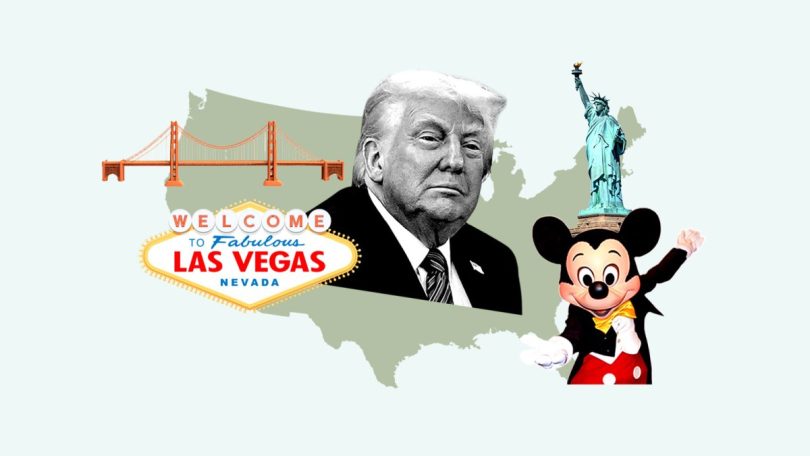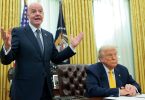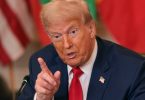Tourists are turning their backs on the US as President Trump’s divisive rhetoric leaves them seeking alternative destinations.
Industry leaders said there were growing signs of “Trump Slump 2.0”, with airlines and destinations cutting their forecasts for 2025.
This week New York City reduced its forecast by three million visitors, citing growing negative sentiment toward the US. It expects two million fewer international visitors and one million fewer domestic arrivals.
Only two months ago, the city’s tourism board predicted that 2025 would break records, with visitors surpassing pre-pandemic levels. It now looks like a distant wish.
The effects are also being felt in Las Vegas, where arrivals have dropped by 7.8 per cent, according to the city’s Convention and Visitors Authority. It welcomed 3.39 million visitors in March, compared with 3.68 million in February.
There has also been a 3.9 per cent drop year-on-year in the number of passengers at Harry Reid international airport, the main gateway to Sin City. Takings at casinos in the city are down by almost 5 per cent over the past year.
Concerns about heavy-handed US border controls are seen as partly to blame. A 28-year-old British woman was held at an immigration detention centre in Washington state for three weeks in March. Rebecca Burke, 28, had attempted to enter the US from Canada, and questions arose at the land-border crossing whether she had the correct visa.
Two German tourists were also deported after trying to enter the US from Mexico. Both had spent weeks in a detention centre in San Diego, and said they were unclear why they had been detained. Another pair of German tourists were deported from Hawaii because their gap year travels were deemed “suspicious”, even though they had the correct Electronic System for Travel Authorisation (Esta) visa.
The travels of Charlotte Pohl, 19, and Maria Lepere, 18, were deemed suspicious
When Skift, the US travel trade publication, surveyed 63 senior industry leaders, including 24 chief executives, it found that 60 per cent believed Trump’s first 100 days had had a negative impact on their sector. The most commonly cited word was “uncertainty”.
More broadly, US government data shows that overseas visitors dropped by 11.6 per cent in March compared with the previous year, including a 17.2 per cent fall in people travelling from western Europe.
The figures rebounded somewhat in April, notably European arrivals, helped by Easter falling late. Overall numbers rose 0.4 per cent year-on-year while western Europe rose 12.1 per cent.
Yet the storm clouds are far from clearing. Holiday companies have witnessed a softening in demand and anecdotally bosses say they are receiving more queries about entry requirements after the news coverage of tourist deportations.
Data from TravelSupermarket, the comparison website, for The Times showed that searches for US holidays had fallen by 36 per cent since January, compared with the same period in 2024. Among long-haul destinations, the US has fallen from top of the table to third place.
“It’s still early days, but historically, political changes in the US have influenced international travel,” said Steph Marinkovic from the comparison site. “Some holidaymakers may be rethinking trips to the US. It’s something to watch as we move into the summer travel season.”
Searches to Canada, meanwhile, were up 221 per cent. Marinkovic said: “We believe Canada may also be benefiting from travellers looking for North American experiences while choosing to avoid its southern neighbour, given the United States’ significant decline in popularity.”
Virgin Atlantic said it had witnessed the early signs of a slowdown in demand for transatlantic flying, especially from US customers. Last month, Oli Byers, chief financial officer, said the airline had “started to see some signals that US demand had been slowing”, adding: “We think that is quite a natural reaction to general consumer uncertainty.”
Aviation analysts are concerned that transatlantic flying could be hit by the worsening economic picture in the US, as well as tensions between the US and Europe, including over tariffs. Trump’s removal of levies since his “liberation day” in April is believed to have helped ease some of the fears.
Yet airfares on the normally lucrative transatlantic routes remain stubbornly low over the summer, pointing to a supply and demand imbalance. Typically fares between the UK and the US rise to about £1,000 return in July and August, yet at present there are returns for less than £400 during the school holidays:
An airline source said: “There is lots of spare capacity on lots of the US routes. Holidaymakers are understandably nervous because of how negative a lot of the news out of the States is and people don’t know what Trump will do next. It’s actually the Canadian routes that are trending up over the summer school holidays.”
Tourism to the US suffered during Trump’s first term, with travel companies branding the fall in demand as a “Trump slump”. Arrivals tanked from March 2017 when the president announced a ban on laptops and large electronics on direct flights to the US from ten major airports in the Middle East and North Africa.
Even once the ban was lifted in July that year, tourism struggled. The feeling was particularly acute among millennials and Generation Z travellers — those born from the mid-1990s to early 2000s. STA Travel, the youth travel company that folded in 2020, said in 2019 that bookings to the US had fallen by more than a fifth during the first two years of Trump’s presidency.
Yet history shows that bookings tend to rebound in the end. “It’s additional uncertainty which we never welcome but we’ve always been able to manage,” said Willie Walsh, the former boss of British Airways who is now the director-general of the International Air Transport Association.
“There remains a lot of speculation around the potential impacts of tariffs and other economic headwinds on travel,” he said. “While the small decline in demand in North America needs to be watched carefully, March numbers continued to show a global pattern of growth for air travel.”











